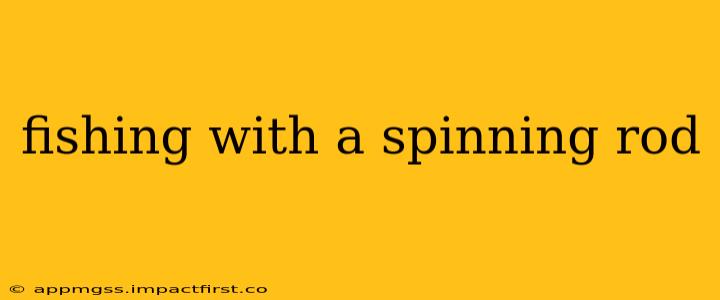Spinning rods are incredibly versatile, making them a popular choice for anglers of all skill levels. Whether you're targeting trout in a stream, bass in a lake, or saltwater species from the shore, understanding the nuances of spinning rod fishing can significantly improve your success. This comprehensive guide will cover everything from choosing the right gear to mastering essential techniques.
What is a Spinning Rod and Reel?
A spinning rod is characterized by its long, slender design and the way the reel is attached – it sits below the rod, allowing for a smooth, underhand cast. This contrasts with baitcasting reels, which sit on top of the rod. Spinning reels utilize a bail arm to manage the fishing line, making them generally easier to learn, particularly for beginners. The combination of the rod and reel is crucial for effectively delivering lures and baits to your target.
What are the different types of spinning rods?
The type of spinning rod best suited for you depends largely on what you plan to fish for and where. Here's a breakdown:
- Ultra-light: These rods are incredibly sensitive, perfect for finesse fishing with small lures for panfish or trout in smaller bodies of water.
- Light: Ideal for a wide range of applications, from targeting bass with small crankbaits to fishing for trout with spinners.
- Medium: Versatile rods suitable for a variety of fish and lure types. A good all-around choice.
- Medium-heavy: Offers more power for larger fish and heavier lures, perfect for bass fishing with larger lures or targeting saltwater species.
- Heavy: Built for strength and power, these rods are ideal for targeting large, powerful fish, often in saltwater environments.
What kind of line should I use with my spinning rod?
The best line for your spinning rod depends on the type of fishing you’re doing. Consider these factors:
- Monofilament: A classic choice, monofilament line is relatively inexpensive, has good abrasion resistance, and is easy to work with.
- Fluorocarbon: Less visible underwater, fluorocarbon boasts higher abrasion resistance and strength than monofilament, making it a popular choice for many anglers.
- Braided line: Extremely strong and thin, braided line offers incredible sensitivity and allows for long casts. However, it can be more prone to abrasions.
How do I cast a spinning rod?
Proper casting technique is essential for accurate presentations. Here's a breakdown of the steps:
- Pinch the line: Hold the line against the spool with your index finger.
- Grip the rod: Hold the rod firmly but comfortably.
- Backswing: Smoothly swing the rod back, keeping the rod tip high.
- Pause: Briefly pause at the end of your backswing.
- Forward cast: Smoothly bring the rod forward, releasing the line with your finger as you cast.
- Follow-through: Follow through with the rod, allowing the lure to fly to its target.
What are the best lures for spinning rods?
The versatility of spinning rods allows you to use a wide range of lures:
- Spinnerbaits: Great for covering water and targeting aggressive fish.
- Crankbaits: Effective for targeting fish in specific areas or depths.
- Spoons: Simple yet effective lures that mimic the movement of baitfish.
- Soft plastics: Versatile and adaptable to various fishing situations.
- Jigs: Versatile lures, capable of attracting many different types of fish.
How do I maintain my spinning rod and reel?
Regular maintenance will extend the lifespan of your equipment. This includes:
- Cleaning the reel: Regularly rinse your reel with freshwater to remove saltwater or grime.
- Lubricating the reel: Apply reel lubricant to maintain smooth operation.
- Inspecting the line: Regularly check your line for nicks or abrasions. Replace it when necessary.
- Storing the rod properly: Store your rod in a safe, dry place to prevent damage.
What are some common mistakes to avoid when spinning fishing?
- Using the wrong rod: Using a rod that's too light or heavy for the target species or lure can significantly impact your success.
- Incorrect casting technique: Poor casting technique can lead to tangles, inaccurate casts, and missed opportunities.
- Ignoring line management: Letting your line become tangled or damaged can result in lost fish or broken equipment.
- Neglecting rod and reel maintenance: Regular maintenance is vital for keeping your gear in optimal condition.
Mastering spinning rod fishing requires practice and patience, but with the right technique and equipment, you'll be landing fish in no time. Remember to prioritize safety and respect the environment while enjoying your time on the water.
